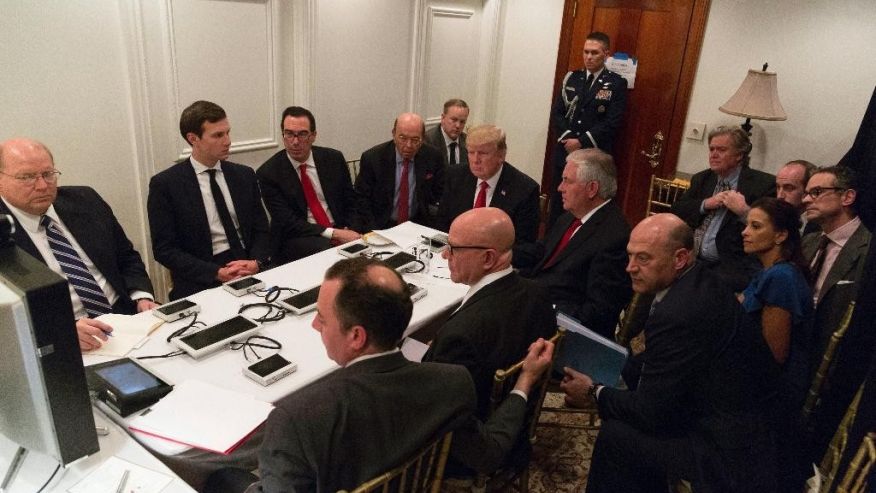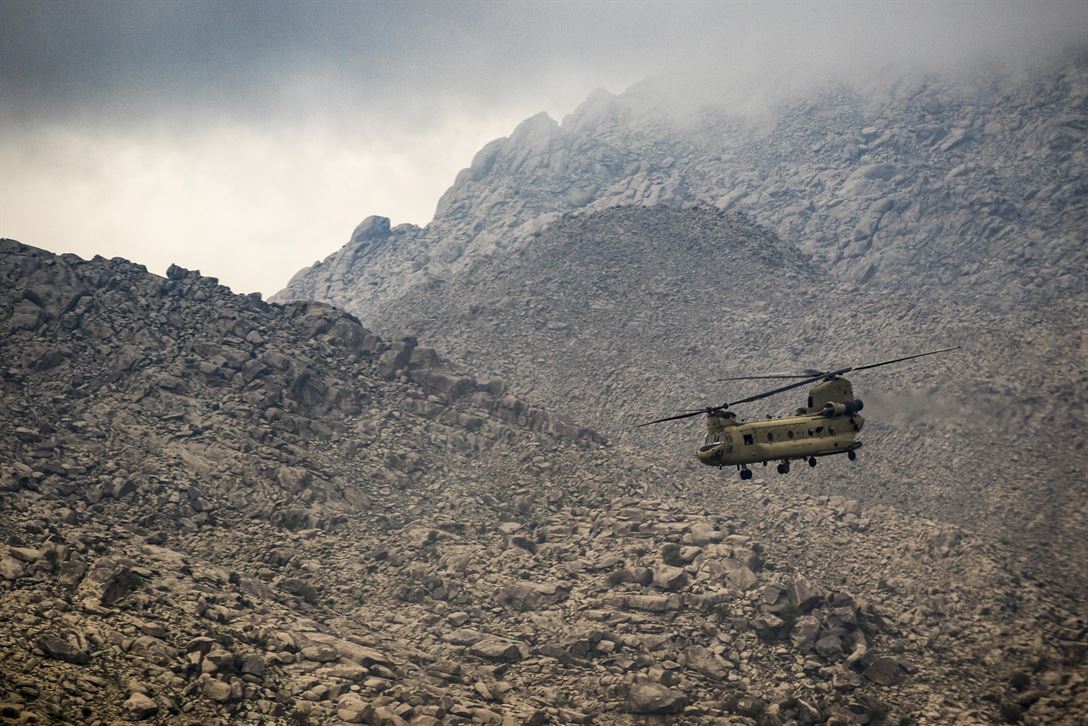
Authored by Ivan Eland via The Strategic Culture Foundation,
During his campaign for the presidency, Donald Trump touted his nationalist “America First” foreign policy, which implied that he wanted to stay out of foreign brushfire wars. Even before that, he tweeted his disapproval of American involvement of the Afghan War.
The photograph released by the White House of President Trump meeting with his advisers at his estate in Mar-a-Lago on April 6, 2017, regarding his decision to launch missile strikes against Syria
Yet now he has delegated the authority to his Secretary of Defense to send several thousand more troops to Afghanistan to join the almost 9,000 that remain there advising and assisting Afghan forces and hunting Islamist terrorists. And that is not the only instance in which the Trump administration has gone against his original inclination or is contemplating it.
Trump appears to be delegating the troop re-escalation decision for Afghanistan to Secretary of Defense Jim Mattis, because the president wants to be able to dodge responsibility in case that policy is ultimately unsuccessful, just as he blamed the botched Special Operations raid in Yemen on the military. Re-escalation is likely to fail, because the administration has no strategy for turning the already-lost conflict around. Adding 3,000 to 5,000 troops, according to a U.S. military that never wants to admit losing a war, would allow American troops to “advise” Afghan troops in battlefield areas, instead of remaining at higher headquarters, and also to call in U.S. air and artillery strikes in support of those local forces.
Yet the Afghan War is the longest conflict in American history, and no conception of “success” can be realistically imagined. How can an augmented force of 13,000 or 14,000 American advisers have success helping a still pathetic Afghan military (even after 16 years of U.S. training), when 100,000 much more potent U.S. combat troops could not defeat the Taliban during all those prior years of conflict?
And if the Taliban’s gains on the battlefield aren’t enough, the continued U.S. military presence in Afghanistan has caused some Islamist militants to pledge allegiance to the even more radical and brutal ISIS group. One can easily see that when the 3,000 to 5,000 troops have little effect on the battlefield, which is the probable outcome, the military will begin demanding a more sizeable re-escalation of the endless conflict.
Should we give the U.S. military a blank check for perpetual war until it comes up with a face-saving way to exit with honor? Such a ruse didn’t fool anyone in the Vietnam War.
India’s Interests
The original U.S. enemy, Al Qaeda, is already a spent force in that part of the world. In addition, the Indian government is assisting Afghanistan economically and Afghan forces militarily and would have an incentive to do much more if the United States withdrew from the fight. India doesn’t want its arch rival Pakistan’s support of the Taliban insurgents in Afghanistan to result in a Taliban-controlled or influenced Afghan government that will augment Pakistan’s power in the South Asian region. Thus, the United States could let India, which has greater strategic interest in this local war than does the United States these days, take over countering the Taliban and ISIS in the region.

Army CH-47 Chinook helicopter pilots fly near Jalalabad, Afghanistan, April 5, 2017. (Army photo by Capt. Brian Harris)
In addition to re-escalating an already unsuccessful Afghan War, some in the Trump administration want to ramp up the fight in Syria and assistance to the Saudi Arabian-led coalition against the Houthi rebels in Yemen, who are loosely aligned with Saudi-rival Iran.
Trump, seemingly only to prove he was tougher than President Obama was in Syria, mounted a for-show cruise missile attack on a Syrian air base after an alleged chemical weapons attack by the Bashar al-Assad regime. Before the U.S. attack, the Trump administration warned the Russians and the thus the Syrians that it was coming, thus severely mitigating its effect.
Lately, however, some in the Trump administration want to widen the war against ISIS in Syria to include Iranian-sponsored militias that are also fighting ISIS. Yet the perils of escalation in Syria became apparent when a Syrian government plane dropped bombs near U.S.-sponsored rebels, U.S. aircraft shot down the plane, and then the Russians declared that any American aircraft flying over Syrian government-controlled areas would be tracked as potential targets. Russian downing of an American aircraft or vice versa would be an unneeded and dangerous escalation between two nuclear-armed great powers over the outcome of a civil war in a country that is not strategic to the United States.
The desire of some Trump administration officials to go after Iranian-sponsored militias in Syria is part of a larger Trump inclination to support Saudi Arabia in its regional rivalry with Iran in the Persian Gulf. That regional rivalry is also playing out in the destitute country of Yemen, with the United States selling the despotic Saudis a fresh batch of expensive military equipment, some of which will probably be used to kill Houthis in Yemen, including lots of civilians. Yet if Syria is not strategic to the United States, the poor nation of Yemen is certainly not either.
In the Syrian civil war, the United States should sit back and watch its adversaries fight each other — ISIS and other radical Sunni Islamists versus Iran, Iranian-sponsored militias, the autocratic Syrian government, and Russia.
In the internecine conflict in Yemen, the Saudi coalition, which has already killed many civilians, is hardly better than Iran.
In the Afghan civil war, the United States should accept defeat, withdraw its forces — instead of re-escalating the war — and let India fully take over assisting the Afghan military in its fight against the Taliban and ISIS.
In sum, Trump should avoid getting co-opted by the U.S. military and honor his campaign rhetoric, which implied staying out of non-strategic brushfire wars.